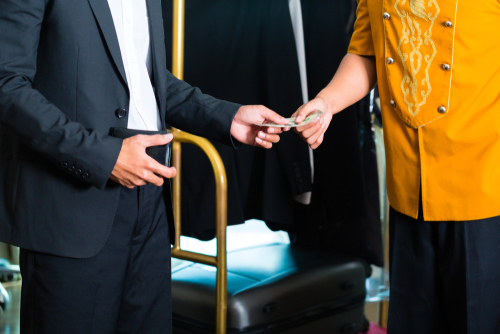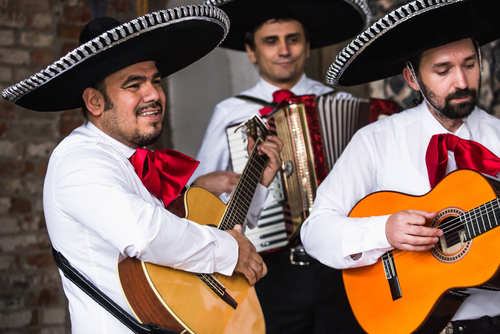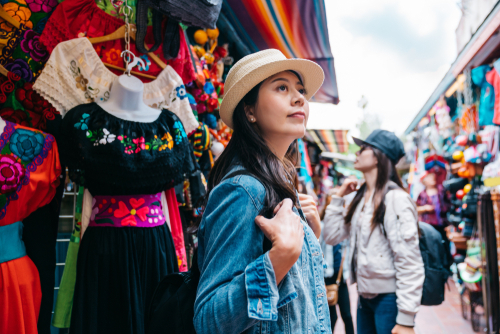Mexico is the kind of country that can take a lifetime to explore. On a trip to Mexico, you’ll enjoy the Yucatan Peninsula, beach resorts on its crystal blue Caribbean coastline, lush jungles, ancient Mayan ruins, and the Pacific Ocean coast along Baja California. The center of Oaxaca and Monte Albán are UNESCO World Heritage sites rich in regional history. In addition, the modern, bustling, and culturally rich Mexico City is only an hour’s drive from the Pyramid of the Sun and Pyramid of the Moon of Teotihuacán. Visit every one of these Mexican treasures, and you’ll still only be scratching the surface of all the country has to offer.
There’s so much to do, see, learn, and eat in Mexico — each of the country’s nine regions boasts a uniquely delicious cuisine — that it’s hard to take it all in, even if you’re fortunate to make your way there on several occasions. So instead, the best way to take advantage of what Mexico offers is to immerse yourself in Mexican culture and get to know its people.
Key Points
- Mexicans enjoy life at a slower pace — go with it and embrace Mexican time!
- Showing others respect and courtesy are the cornerstones of Mexico’s rules of etiquette.
- If you’re not sure how much to tip, err on the side of generosity.
- It’s important to respect Mexican rules around gender, especially when it comes to how men interact with women in social and business settings.

Understanding Mexico and its travel etiquette will enhance your experience as you travel and can make you a great ambassador of your home country.
The Importance of Etiquette in Mexico
Mexicans have a well-earned reputation for being welcoming hosts to tourists and business visitors from around the world. A North-America-meets-Latin-American-country, as Mexico borders the United States to its north and Guatemala and Belize to its south, Mexicans are decidedly modern people who hold onto old-fashioned notions of manners that encompass values and respect.
If you’re planning a trip to Mexico and want to put your best foot forward, this article explains what you need to know about proper etiquette in Mexico.
Embracing “Mexican Time”
With some big city exceptions — such as the booming metropolises of Mexico City and Monterrey — Mexicans move at a gentler pace than most Americans, Canadians, and Europeans are used to experiencing. If you can accept this fact from the get-go, your time in the country will be much more “tranquilo” — or Spanish for “calm.”
You may hear references to “Mexican time,” which has nothing to do with clocks or time zones. Instead, Mexican time is a tongue-in-cheek way of explaining that precise punctuality is of little importance.
Showing up at a host’s home on time is the height of rudeness. Plan to be at least 30 minutes — or even up to a couple of hours — late. Rather than getting frustrated, embrace this altered-time universe as a guest in the country. If the waiter takes their sweet time bringing you the check, take a deep breath, relax, and take a few more sips of your margarita. Except for medical appointments and some business meetings, everything in Mexico will move slower than your normal pace.

When and How to Tip in Mexico
Tips — usually referred to as “propinas” in Spanish — are common in Mexico. While tipping will depend on the type of service provided and the situation, how much to tip will depend on where you are. If you’re in an area teeming with American tourists, the expectation is to provide a 15% to 20% tip. If you’re in an area that caters more to the locals, a tip of 10% to 15% is the norm. Sometimes, restaurant owners work the gratuity into the bill’s total, so you won’t be expected to add a tip at all.
If you’re staying at an all-inclusive Mexican resort with a no-tipping policy, you can still slip some extra Mexican pesos to anyone who provides you with exceptional service. It’s a good idea to keep extra pesos on you at all times for tips. If you plan to tip using U.S. dollars, only use bills, as your recipients won’t be able to exchange U.S. denomination coins for pesos.
Tipping for Taxis
Generally speaking, taxi drivers don’t expect a tip. However, many people will tack on a small tip of 10 pesos or so — equivalent to $0.50 USD — if the cab driver assists them with luggage. The same goes for airport shuttle services. Again, a tip isn’t required, but offering 10 Mexican pesos per bag is always appreciated.
For drivers who act as tour guides, tack on a 10% to 20% tip to the agreed-to fee. This rule applies to all tour guides, whether providing a private service or leading a group excursion.
Tipping at Hotels
Tip hotel bellhops 25 to 50 pesos ($1.25 to $2.50 USD) for bringing your bags to your room. For hotel or guest house housekeeping services, the expected tip is 25 to 50 pesos per day.

If possible, leave a tip each day rather than at the end of your stay, as the same staff may not attend the same rooms every day. If you use the services of a hotel concierge — perhaps you received assistance with restaurant reservations, arranging for excursions, or airport transportation — an apt tip ranges from 50 to 100 pesos (approximately $2.50 to $5.00 USD).
Tipping Gas Station Attendants
If you’re driving a car around Mexico, you’ll need to know the tipping protocols at gas stations.
A thing of the past in most of America — with New Jersey and Oregon being notable exceptions — many gas stations in Mexico provide full service, which means that attendants will pump your gas and wash your windows. It’s typical to pay cash for gas and tip the attendant. You can either round up the purchase amount in “keep the change” (or “quédese con el cambio” in Spanish) fashion or add 10 pesos or so to the total amount.
Tipping Bathroom Attendants
Some of the restrooms in higher-end restaurants, clubs, and hotels in Mexico will have attendants. Their job is to keep the restrooms clean and provide you with towels, soaps, deodorants, hair care products, or anything else you might need to freshen up.
There will be a tip jar next to the attendant station where you can leave a gratuity. While not required, it is always nice to leave 10 or 20 pesos. Note that if you use an attended restroom facility more than once while at an establishment, it’s unnecessary to tip each time.
Tipping for Salon and Spa Services
It’s customary to tip 15% to 20% for hairstyling and spa services, such as massages, facials, and other beauty treatments. Sometimes — especially at resorts — the gratuity is already included. If that’s the case, no additional tip is necessary, although adding 10% or more for great service is always appreciated.
Tipping Musicians
Music is a huge part of Mexican culture, and many restaurants provide music as part of the dining experience. So it’s not uncommon for a mariachi band to walk up to your table, invited or not.

Of course, you’re always welcome to send them away with a polite “no, gracias,” but if they play a song or two at your table, they will expect a tip. Twenty pesos will suffice but think about upping that to 50 if you can. Most musicians survive on tips alone, and this is one of the more unique and festive aspects of dining out in Mexico.
Tipping Waitstaff and Bartenders
Tipping in restaurants in Mexico follows the same basic rules as most countries. If a bill arrives with a 10% or 15% tip included, think about tacking on a bit extra for exceptional service. If the bill arrives without a gratuity attached, 15% or 20% is the norm, and 10% of the total bill should be the absolute minimum.
Tipping for food service only applies to sit-down restaurants. You don’t need to tip when purchasing tacos and tortillas or other street food from open-air vendors.
The same general rules that apply to food servers also apply to bartenders. However, if you’re hanging around for a while, and the service and drinks are particularly good, you might want to tip on the higher end.
Mexican Restaurant Etiquette
Dining in restaurants in Mexico is one of the best ways to experience the regions of the country. No matter where in Mexico you are dining, the same rules of etiquette will apply. Especially in situations when a Mexican local invites you to dine at a restaurant.
- Seating arrangements. If you’re a guest, don’t sit until your host directs you. The head of the table is the most honored position and reserved for an elder, a boss (jefe), or the guest of honor. The next most important guest will be seated to the hosts’ right, with the male guest to the hostess’s right and the female guest to the host’s right.
- Dining manners. Wait until everyone is served before starting to eat. Nobody should begin eating until the host says, “buen provecho!” — the Spanish version of “bon appetit” or “enjoy your meal”. Don’t switch knives and forks between your hands, and keep your hands visible while at the table. When not eating, rest your wrists on the table, as resting your elbows may seem disrespectful. When finished eating, lay the knife and fork parallel to each other across the right of your plate. If you need to leave a meal early, always excuse yourself and wish everyone at the table “buen provecho.”
- Paying the bill. The host — the one who invited you — will pay the bill. It’s not usual in Mexico for parties to split the bill. To reciprocate, invite your host to dine out on another occasion.
- Don’t rush service. Recognize that service might be slower in a restaurant in Mexico than in your home country. Therefore, don’t rush the service. If you need to call a server, you can call a waiter “joven” or politely call out “por favor, senor” — or senora or senorita, as appropriate. Never clap your hands or snap your fingers. Usually, a waiter won’t bring your bill unless and until you ask.
Mexico Public Transportation Etiquette
Getting around Mexico in public transportation is a great way to get away from tourist areas and connect with the Mexican people. However, whether you travel on city mini buses — called colectivos or peseros — in the country’s tiered bus system or by subway or rail, there are some etiquette rules you should follow if you want to avoid offending your fellow passengers.
- Let people off first. Mexican transportation is usually crowded and hectic. If you block the doorways, exiting passengers can’t get off to make room for you and others. If you’re blocking the doors from inside, step off momentarily to let others exit.
- Be polite. If you need to squeeze past someone, say “con permiso,” which translates to “with your permission.” If you accidentally step on someone’s toes or inadvertently block their path, be sure to apologize by saying “perdón” (sorry).
- Be mindful of your space. Don’t hug support poles or take up more than a single seat with bags or other personal items. And give up your seat to the elderly, pregnant women, and parents with small children.
- Be aware of gender-specific cars. Some Mexican cities have rail cars designated exclusively for women and young children. Don’t enter these cars unless you meet the category designation.
How to Dress for Different Occasions in Mexico
There are only a few hard-and-fast rules you should be aware of when it comes to dressing appropriately in Mexico.
- While casual streetwear is acceptable when exploring the country, be aware that nobody wears shorts in public in Mexico City. Residents of the capital city tend to dress more sophisticatedly than their coastal or smaller town counterparts. If you don’t want to stick out like a sore thumb, you might want to dress a bit more formally when in the city.
- Always remove your hat when entering a church or chapel.
- If invited to dine at the house of a Mexican, casual dress is acceptable.

Etiquette During Mexican Social and Business Events
How Mexicans behave in certain social and business situations may differ from what you are used to in your home country. A few matters to keep in mind are:
- It’s only common to be punctual with business events. Never show up early or on time for a social event, as it can be considered rude.
- Whether entering a room for a social or business event, it’s customary for a man to shake hands with each man in the room. Likewise, a man should also greet each woman, but he should wait for her to extend her hand before they shake hands. If she doesn’t, he should greet her with a slight bow.
- When it comes to greeting friends, females will often kiss other females and males on the cheek. Likewise, men will often greet each other with a quick hug and pat on the back. The same ritual is required when leaving an event.
- When meeting someone for the first time, use their title followed by their surname. It’s usually not considered polite to use a person’s first name until invited to do so. As in other Latin American cultures, Mexicans have two surnames — their father’s name and their mother’s. Use the first surname following the appropriate title: señor, señora, or señorita (Mr., Mrs., Miss). Where appropriate, use a person’s professional title: licenciado or licenciada for lawyers (and some other professions that require a college degree), maestro or maestra for elementary schoolteachers, profesor or profesora for secondary or college teachers, and doctor or doctora for physicians.
Mexican Cultural Nuances
In Mexico, manners are important. People raised well are considered cultured or well educated (bien educado), and rude people are considered poorly raised or poorly educated (mal educado). As a rule, Mexican people are very welcoming of foreigners and, as long as you present yourself as bien educado, you’ll be accepted and embraced.
Some ways that tourists can be perceived as poorly raised are:
- Bartering inappropriately. Some tourists think bartering is the norm in Mexico. Except for some artisan markets outside of major cities, it isn’t. Pay the price presented — it’s undoubtedly cheaper than you would pay at home anyway — or walk away.
- Not even attempting to speak Spanish. Yes, many Mexicans know English — especially in the bigger cities — but that doesn’t mean you shouldn’t at least try to learn some basic Spanish. At a minimum, learn how to greet and address people in Spanish properly.
- Not accepting hospitality. If offered a seat or something to drink, by all means, accept. Mexicans are hospitable people, and refusing their goodwill can seem rude.
- Failing to bring flowers when visiting someone’s home. If invited to someone’s home, send or bring flowers for your hostess. You can also bring a bottle of wine or chocolates. Never show up empty-handed.
Discover Mexico Through VacationRenter
If you’re ready to immerse yourself in the immense beauty and culture of Mexico, VacationRenter can help you find the ideal vacation rental to bring your plans to life. We bring together all the best Mexican rental options from the major travel sites, so you can find the vacation rental of your dreams without spending hours searching and scrolling.
Let VacationRenter help you find the perfect Mexican vacation rental today.